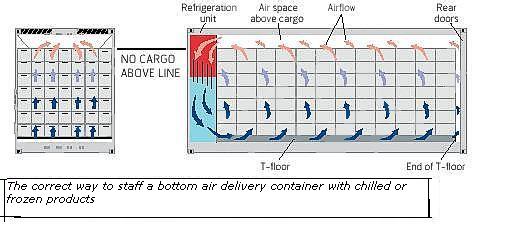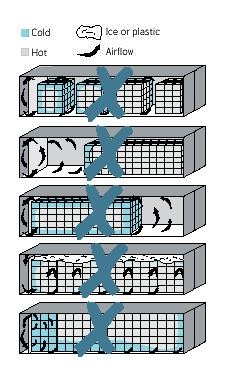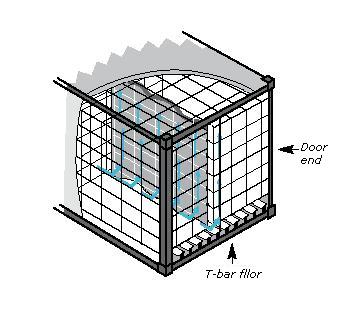
Home page||Ship employment
||
Reefer cargo stuffing- Pre-cooling, treatment & handling of a reefer container
Pre-treatment of reefer products prior stuffing
The condition of reefer products before they are stuffed plays an
important role in their condition upon arrival. That is why
it is essential that all products are treated correctly prior
to stuffing. Even though the temperature, ventilation and
humidity are all optimal during the entire voyage, products
will only arrive in perfect condition if the pre-treatment has
been performed correctly. Successful shipping begins at the
product sourcing area.
Pre-cooling of cargo
The proper pre-cooling of products will have a positive
effect on both shelf life and out turn, compared to products
that have not been pre-cooled. Reefer containers are built
primarily to maintain the temperature of the products,
therefore, products should always be pre-cooled to the
required carriage temperature prior to being loaded into
the container.
No pre-cooling of reefer container itself
Pre-cooling of the reefer container itself should never take
place. Once the doors of a pre-cooled container are opened,
hot ambient air will meet internal cold air, resulting in a large
amount of condensation on the interior surfaces.
As a result, condensed water may drip from the roof of the
container and cause stains and weaken the structure of the
boxes. Therefore, condensed water must be removed through
the evaporator located inside the reefer machinery. Heat that
enters the container during stuffing, combined with heat that
is constantly generated by the “respiring” cargo, must also be
removed through the evaporator.
As soon as water and heat pass the evaporator, ice is formed
and the machinery enters a short defrost mode. Consequently,
there will be less capacity available for cooling the cargo.
In a tropical climate with excessively hot and humid air, any
pre-cooling of the container is likely to cause problems and
damage the products.
Pre-cooling of the reefer container is only allowed when
the container is connected to the cold store and the
temperatures are identical. The connection is achieved by the
use of a “Cold Tunnel” – a tight duct between the cold store
and the container, which prevents ambient air from entering.

Fig 1 :Correct way of stuffing chilled cargo
Things to do during stuffing
The stuffing and placement of cargo will directly affect
the flow of air. Figure above illustrates the correct way to stuff
a bottom-air delivery reefer with chilled or frozen cargo.
In the case of chilled cargo, covering the entire floor with
cargo forces the cool air to flow through both the cartons
as well as the product, throughout the entire load. When
frozen cargo is stuffed in this manner, the cold air flows
around the cargo – blanketing the cartons and removing
any heat that enters the reefer container through the walls.


Fig 2 :Improperly stuffed chilled or frozen cargo
Things not to do during stuffing
Air always takes the path of least resistance. Here are a few
examples that illustrate reefer cargo which has
been stuffed improperly. In the first three examples, air tends
to “short circuit” or flow past the cartons/products rather
than through them. The last two examples illustrate restricted
airflow scenarios.
Never run a reefer with doors open
When the ambient temperature is warmer than the cargo,
operating the reefer with the rear doors open will not cool
down the cargo . Rather, the introduction of hot
ambient air will heat up the cargo. When hot humid air enters
the reefer, moisture condenses on the cold cooling coil and
turns to ice.
Cooled air escapes through the rear door, and the
cycle continues. Once stuffing is complete and the doors are
closed, the reefer could run for hours with a partially iced-up
cooling coil. This would reduce its cooling effect and put the
cargo in danger until the unit completes a defrost cycle.
Further, the genset should be stopped during stuffing,
due to the risk of exhaust gas reaching the fresh cargo.
Fig. 1 The correct way to stuff a bottom-air delivery
container with chilled or frozen cargo
To avoid cargo damage :
• do not leave any areas open or uncovered on the floor,
the front bulkhead or the side walls (if pallets are placed
at the front bulkhead, be sure to place cardboard under
empty pallets)
• do not run unit with rear doors open
• do not stuff cargo beyond the end of the T-floor
• do not plug channels at the end of the T-floor
• do not stuff cargo above the red load line
• do not put reefer set point at a temperature below what
is required for the cargo (this will not expedite the
cooling process)


Fig 3 : Optimal stuffing of reefer cargo, Fig: Reefer container inside
Optimal stuffing – Top View
Covering the floor in a proper manner will improve the flow
of air and hence, refrigeration. In order to force air up and
through the cargo, the entire floor should be covered. Cover
the floor from the front bulkhead to the end of the T-floor.
Where the cargo does not cover the floor, some type of filler
should be used, such as dunnage or cardboard. Do not stuff
past the end of the T-floor with cargo or filler (fig. 3).

Fig 4 : Reefer stuffing for blocking or bracing cargo
Blocking and bracing
For blocking and bracing cargo, wood is still the preferred
material. Use wood as necessary (fig. 4), but do not nail wood
or dunnage to the container. Cover floor with a filler between
pallets to help force air through the cargo (as seen in the Top
4 view, fig. 4). Cover the ends of the last two pallets in order to
force air up and through the cartons. Do not block off airflow
past the end of the T-floor.
Other useful articles :
- Methods of refrigeration
Refrigeration is essentially the removal of heat through
the process of evaporation. We choose to refrigerate
commodities such as fruits and vegetables because we
want to prolong their “practical shelf life” – the time from
harvest until the product loses its commercial value.
More .....
-
Reefer cargo stuffing
it is essential that all products are treated correctly prior
to stuffing. Even though the temperature, ventilation and
humidity are all optimal during the entire voyage, products
will only arrive in perfect condition if the pre-treatment has
been performed correctly. Successful shipping begins at the
product sourcing area.
More .....
-
Growing demand for container refrigeration
On deck refrigerated containers are generally serviced by clip-on air cooled electric motor drive cooling units. The units are plugged into the
ships electrical system by way of suitable deck sockets.
More .....
-
Frozen products packaging requirement
Proper packaging procedures will help protect frozen cargo
during transport. Frozen products do not require air holes in
the top and bottom of the cartons. Air flowing around the load
is sufficient to remove heat that has penetrated the container.
The cartons should be stacked directly on top of each other to
take advantage of their strength in the corners.
More .....
- Packaging & stowage guideline for reefer cargo
Packaging plays an important role when it comes to protecting the cargo. The packaging material must be able
to support a stacking height of up to 2.4 metres (7’10’’).
The material should be able to withstand humidity without
collapsing, and should allow the passage of an adequate
vertical airflow through the cartons in order to maintain the
desired temperature..
More .....
- Choice of packaging for various commodities
Goods should be well stowed within the package,
evenly distributed and properly secured. Items
completely filling the case or carton contribute to
the strength of the whole package. Items which do
not completely fill the package must be cushioned
against shock or vibration.
More .....
- How to keep cargo fresh ?
Proper ventilation of fresh, chilled products is necessary to
remove the heat, carbon dioxide and other gases produced
by the cargo. Heat is removed by continuously circulating
the internal air, whereas carbon dioxide and other gases are
removed by replacing the internal air supply with cooled
fresh air..
More .....
- Loading precautions for refrigerated cargoes
Refrigerated cargoes include meat carcases, carton (packed) meat, fruit, cheese, butter, fish and offal. Ships are specifically designed for their carriage, with separate spaces in holds and ’tween decks, each fitted with suitable insulation and individual control of ventilation. Ordinary general cargoes may be carried in the spaces at other times, the temperature being regulated accordingly for the type of cargo being carried.
More .....
- Role classification societies maintaining seaworthiness of vessels
classification societies publish rules and regulations which are principally concerned with the strength of the ship, the provision of adequate equipment, and the reliability of the machinery .
More .....
- Periodic survey requirement by classification societies
To maintain the assigned class all steel ships are required to be surveyed and examined by the Society’s
surveyors at regular periods.
The major hull items to be examined at these surveys only are discussed
here..
More .....
Machinery system main info pages
Home page||Cooling ||Machinery||Services ||Valves ||Pumps ||Auxiliary Power ||Propeller shaft ||Steering gears ||Ship stabilizers||Refrigeration||Air conditioning ||Deck machinery||Fire protection||Ship employment
||
Home ||
General Cargo Ship.com provide information on cargo ships various machinery systems -handling procedures, on board safety measures and some basic knowledge of cargo ships that might be useful for people working on board and those who working in the terminal. For any remarks please
Contact us
Copyright © 2010-2016 General Cargo Ship.com All rights reserved.
Terms and conditions of use
Read our privacy policy|| Home page||